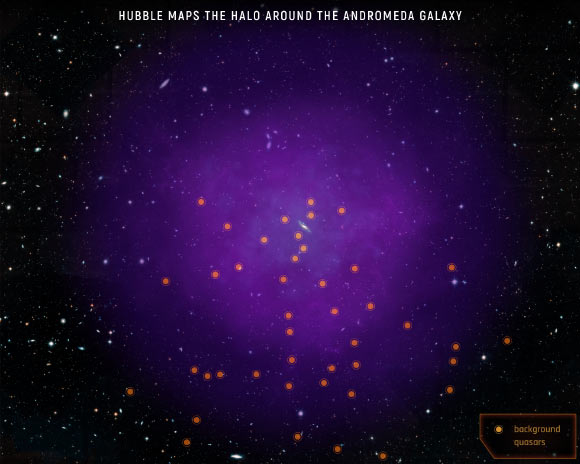Astronomers using the NASA/ESA Hubble Space Telescope have found that a halo of diffuse plasma around the Andromeda galaxy, which is located 2.5 million light-years away, extends 1.3 million light-years from Andromeda — about halfway to our own Milky Way Galaxy — and as far as 2 million light-years in some directions. They’ve also found that Andromeda’s halo has a layered structure, with two main nested and distinct shells of gas.

This image shows the location of the 43 quasars Lehner et al used to probe Andromeda’s gaseous halo. These quasars are scattered far behind the halo, allowing scientists to probe multiple regions. Looking through the immense halo at the quasars’ light, the team observed how this light is absorbed by the halo and how that absorption changes in different regions. By tracing the absorption of light coming from the background quasars, the astronomers are able to probe the halo’s material. Image credit: NASA / ESA / E. Wheatley, STScI.
To create a map of the Andromeda halo, University of Notre Dame astronomer Nicolas Lehner and colleagues examined the light from 43 quasars located far beyond Andromeda.
The quasars are scattered behind the halo, allowing the researchers to probe multiple regions.
Looking through the halo at the quasars’ light, the team observed how this light is absorbed by the Andromeda halo and how that absorption changes in different regions.
“Understanding the huge halos of gas surrounding galaxies is immensely important,” said Dr. Samantha Berek, a researcher in the Department of Astronomy at Yale University and the Department of Physics at the University of Notre Dame.
“This reservoir of gas contains fuel for future star formation within the galaxy, as well as outflows from events such as supernovae.”
“It’s full of clues regarding the past and future evolution of the galaxy, and we’re finally able to study it in great detail in our closest galactic neighbor.”
“We find the inner shell that extends to about 500,000 light-years is far more complex and dynamic,” Dr. Lehner said.
“The outer shell is smoother and hotter. This difference is a likely result from the impact of supernova activity in the galaxy’s disk more directly affecting the inner halo.”
The scientists used the unique capability of Hubble’s Cosmic Origins Spectrograph (COS) to study the ultraviolet light from the quasars.
Ultraviolet light is absorbed by Earth’s atmosphere, which makes it impossible to observe with ground-based telescopes.
The team used the COS instrument to detect ionized gas from carbon, silicon, and oxygen. An atom becomes ionized when radiation strips one or more electrons from it.
“This is truly a unique experiment because only with Andromeda do we have information on its halo along not only one or two sightlines, but 43,” Dr. Lehner said.
“This is groundbreaking for capturing the complexity of a galaxy halo beyond our own Milky Way.”
The results were published in the Astrophysical Journal.
_____
Nicolas Lehner et al. 2020. Project AMIGA: The Circumgalactic Medium of Andromeda. ApJ 900, 9; doi: 10.3847/1538-4357/aba49c







